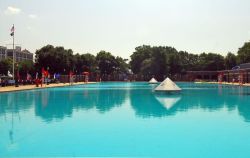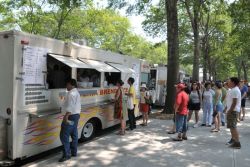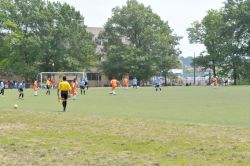Red Hook Recreation Area
Red Hook Park
The history of Red Hook tells the story of a unique and vibrant neighborhood that has continually reinvented itself. Settled by the Dutch in 1636, the area was originally called Roode Hoek for the reddish color of the soil and the distinctive shape of the land.
Two hundred years after the arrival of the first settlers, Red Hook’s marshy land remained rural and undeveloped. Not until the construction of the Atlantic Basin in the 1840s did Red Hook begin to grow. The Atlantic Dock Company developed piers in the Atlantic Basin, and William Beard, a railroad contractor, built up wharves in nearby Erie Basin. The peninsula quickly became one of the busiest shipping centers in the United States.
By the beginning of the Civil War, ships from all over the world docked at Red Hook to receive and unload cargo, and for repairs and maintenance. At the turn of the 20th century, the neighborhood was still bustling and it prospered well into the 1930s and 1940s, when the basin employed over 7,000 people. As one generation of immigrant dockworkers replaced another, the area developed a reputation for toughness. Notorious gangster Al Capone got his start as a small-time criminal and received the wound that led to his nickname, “Scarface,” here in Red Hook. Originally built for the families of dockworkers, the Red Hook Houses opened in 1938 as the first high-rise public housing complex constructed in the city. During the same era, this park (then known as the Red Hook Recreation Center) officially opened. The New York Times reported that at the opening on August 12, 1936, Mayor Fiorello H. LaGuardia (1882-1947) was greeted by the thunderous cheers of more than 40,000 area residents, many of them children.
In the second half of the 20th century, many of the docks became obsolete with the introduction of container shipping. Ports in New Jersey and other southern locations drew business and jobs away. In addition, the massive 1946 construction of the Gowanus Expressway cut Red Hook off from the rest of Brooklyn. This project and the removal of trolley service in the 1950s changed Red Hook from a thriving commercial center to an isolated neighborhood. Between 1960 and 1980, the population of the area dropped from 18,575 to just 10,485.
In recent years, the persistence and inventiveness of Red Hook residents has sparked a comeback. The first sign of renewal was in the 1970s on the west side near the waterfront. There in “the Back,” painters and sculptors discovered they could buy inexpensive row houses through a City program that subsidized housing for artists. The influence of these new residents is seen each spring when a warehouse at the end of historic Beard Street Pier hosts a show featuring exhibitions, performances, and films.
The City acquired the first piece of land for what is now Red Hook Park on October 10, 1913, originally to provide terminal facilities for the marginal freight railroad. The property was not assigned to Parks until June 27, 1934. The other parcels came under Parks jurisdiction between 1935 and 1947. Gilmore D. Clarke (1892-1982), one of America’s most prominent landscape designers at the time, laid out the original development plan for the Recreational Center during the tenure of Parks Commissioner Robert Moses (1888-1981).
The park also contains a paved path, benches, a flagpole with a yardarm, a drinking fountain, handball courts, baseball fields, a soccer and football field, picnic tables, the adjacent Sol Goldman Pool, and new trees and plantings.
Check out your park's Vital Signs
Clean & Safe
Green & Resilient
Empowered & Engaged Users
Share your feedback or learn more about how this park is part of a
Vital Park System







